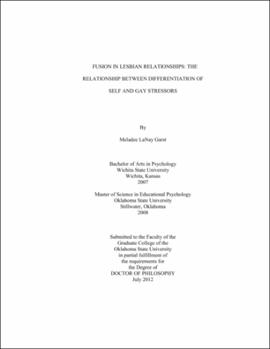| dc.contributor.advisor | Carlozzi, Barbara | |
| dc.contributor.author | Garst, Meladee LaNay | |
| dc.date.accessioned | 2013-11-26T08:33:20Z | |
| dc.date.available | 2013-11-26T08:33:20Z | |
| dc.date.issued | 2012-07 | |
| dc.identifier.uri | https://hdl.handle.net/11244/7217 | |
| dc.description.abstract | Scope and Method of Study: The purpose of this study was to investigate relationship between differentiation of self and gay stressors in a lesbian population. The sample of lesbian women, over the age of 25, and currently in a same-sex relationship of at least one year's duration completed a demographic form, the Differentiation of Self Inventory-Revised (DSI-R), and the Sexual Orientation Stressors Scale (SOSS). Data were analyzed using multiple regression and correlational techniques. | |
| dc.description.abstract | Findings and Conclusions: A significant relationship was found between differentiation of self and reported gay stressors. Lesbians reporting higher levels of differentiation reported fewer gay stressors. Three out of the four DSI-R subscales were significantly and negatively correlated with gay stressors. The subscales for taking the "I" position, emotional cutoff, and emotional reaction all had small to medium effect sizes. The fusion with others subscale was not significantly correlated with gay stressors. Correlational analyses indicated a significant positive relationship between years being "out" and differentiation of self and the four DSI-R subscales. Significant negative correlations were found between years being "out" and the following gay stressors subscales: visibility with work and public, sexual orientation conflict, family reaction to sexual orientation, and family reaction to partner. There was a non-significant relationship between years being "out" and total gay stressors. Multiple regression analyses results indicated that the predictor set of family reaction to sexual orientation, family reaction to partner, visibility to family and friends, visibility to work and public, general discrimination, and sexual orientation conflict were significantly related to both the fusion with others subscale and differentiation of self. This predictor set accounted for approximately 17% of the variance in fusion with others, while accounting for approximately 30% of the variance in differentiation of self. When predictors were examined individually specific types of gay stressors were related to differentiation of self and fusion with others subscale, specifically general discrimination was found to have a significant positive regression weight with the fusion with others subscale; the predictor of visibility with work and public subscale had a significant negative regression weight; the family reaction to sexual orientation subscale, the visibility with work and public subscale, and the sexual orientation conflict subscales all had significant negative regression weights with differentiation of self. | |
| dc.format | application/pdf | |
| dc.language | en_US | |
| dc.rights | Copyright is held by the author who has granted the Oklahoma State University Library the non-exclusive right to share this material in its institutional repository. Contact Digital Library Services at lib-dls@okstate.edu or 405-744-9161 for the permission policy on the use, reproduction or distribution of this material. | |
| dc.title | Fusion in lesbian relationships: The relationship between differentiation of self and gay stressors | |
| dc.contributor.committeeMember | Boswell, Donald | |
| dc.contributor.committeeMember | Dorton-Clark, Julie | |
| dc.contributor.committeeMember | Perry, Katye | |
| osu.filename | Garst_okstate_0664D_12221.pdf | |
| osu.accesstype | Open Access | |
| dc.type.genre | Dissertation | |
| dc.type.material | Text | |
| dc.subject.keywords | differentation of self | |
| dc.subject.keywords | fusion | |
| dc.subject.keywords | gay-related stressors | |
| dc.subject.keywords | gay stressors | |
| dc.subject.keywords | lesbian relationships | |
| dc.subject.keywords | merging | |
| thesis.degree.discipline | Educational Psychology | |
| thesis.degree.grantor | Oklahoma State University | |
